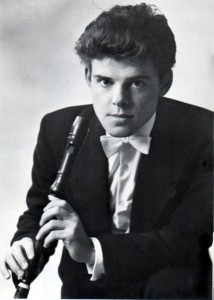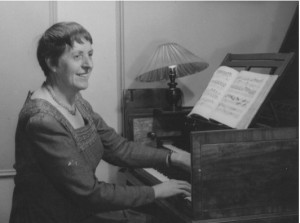Guest Blogger: Peter Dickinson is a composer, writer and pianist and an Emeritus Professor of two universities – Keele and London. See here for more details.
‘My wife and I first met David and Gill Munrow in Cambridge in about 1965. It was summer and we were all in the garden at 54 Bateman Street, the home of Mary Potts, whose late husband was L. J. Potts, the literary critic and English don at Queens’ College.
Mary Potts had a very special role in the early music revival which has not been acknowledged [other than in this Semibrevity blog post]. A mere mention of her more distinguished pupils, who included Christopher Hogwood, Colin Tilney and Peter Williams, is enough to indicate that she ought to be better known now. She knew harpsichordists of international reputation such as Gustav Leonhardt, Raphael Puyana and Kenneth Gilbert. Her own performances were on a more modest scale but she played in and around Cambridge for over fifty years. At May Week concerts she was especially busy taking her harpsichord round various colleges. She became a focus for early music activities long before David Munrow propelled these into a new public orbit through his recitals, lectures and broadcasts. Her influence could perhaps be seen as complementary to that of Thurston Dart in the official Cambridge University Music Faculty.
Mary Potts was born in 1905 and studied at the Royal College of Music from 1923-28 as a pianist but also took harpsichord lessons with Arnold Dolmetsch and was a regular visitor to Haslemere for some years. When she married L. J. Potts she moved to Cambridge in 1930. Her own harpsichord was made in the eighteenth-century by the Swiss-Englishman Burkat Shudi (1702-73): it was bought from Dolmetsch, and some of the first rehearsals of Munrow’s Early Music Consort took place in her music room. She died in 1982 and will long be remembered for her generous and sympathetic encouragement of younger musicians.
Mary Potts was not just involved with the [music of the] past. She encouraged young composers too and I wrote my Variations on a French Folk Tune for her. (Recorded by Jane Chapman, a Potts pupil, on Heritage HTGCD 259)
She gave the first performance at the University Music Club in 1957 and also played the keyboard part in my Quintet for flute, clarinet, violin, cello and harpsichord (now destroyed). This kind of activity makes a productive link with David Munrow who also believed that early music instruments were not just archaic survivals but needed new repertoire.
Please subscribe to this blog – in the top right corner – and receive notifications of new posts by e-mail. In terms of getting information, this is preferable to “liking” the blog (though you can do that too), as Facebook’s money-making system limits the number of people who see our news feed, to as little as 10% of the total sent!
My next contact with Munrow was in connection with my chamber piece he had commissioned called Translations for recorder, gamba (Oliver Brookes) and harpsichord (Christopher Hogwood). The trio was known as the Early Music Consort of London and gave the premiere at the Purcell Room on 20 February 1971. At the time there were very few British works that used multi-phonics for the recorder so we worked out what was possible. I also worked with Oliver Brookes on the use of twentieth-century techniques applied to the viola da gamba. For early music players some of Translations was distinctly innovative – that was the reason for the title. Unfortunately they never recorded it. However, John Turner later gave several performances with Oliver Brookes and Keith Elcombe.
Just over a year after Translations later David commissioned a solo piece – Recorder Music. At this period he was becoming widely known for one of the liveliest programmes broadcast on BBC Radio 3 – Pied Piper, which ran from 1971-76 with over 600 episodes. In addition to all his concert work, lectures and teaching he researched and presented this weekly programme, putting not only himself but his skilled producer the late Arthur Johnson under enormous pressure. (See Peter Dickinson, Arthur Johnson, obituary, The Guardian, 11 December 2014)
Since Munrow went around recording interviews with people I thought it would be perfectly natural for him to come onto the stage, switch on his portable tape-recorder and proceed to perform alongside it. So that was the basis of Recorder Music. I again used a range of material, including multi-phonics, and incorporated my Air for solo flute (1959). (Recorded by Duke Dobing on Naxos 8.572287) I adapted this melody for an instrument David had brought back from his travels in Peru – a notch flute called the kena. Then, knowing what a startling impression this would give in a live performance, I included a march for David to play on two recorders at once – the garkleinflötlein and the sopranino. This comes back at the end but with the much larger tenor and bass recorders together – even more of a mouthful. The live performer is without tape for a central cadenza, which is alarmingly difficult. David arrived at our house one day saying that he’d been practising it for nine hours.
He gave the first performance of Recorder Music on 8 February 1973 at the Wigmore Hall. However, it seemed more satisfactory to have good quality tape-playback rather than a portable machine and this made the whole business inconvenient and expensive. The best medium for this kind of piece is a recording or a broadcast and so David recorded Recorder Music for EMI and it came out in 1975 at the end of his two-LP survey called The Art of the Recorder. (EMI SLS 5022; now on CD with Testament SBT2-1368) I wrote a memorial tribute for a BBC concert in Manchester on 7 May 1977, at which Munrow was to have played Recorder Music. A Memory of David Munrow is for two counter-tenors, two recorders, gamba and harpsichord, using only material from the two pieces I wrote for him.
My last professional connection with David was the strangest of all. He was involved with music for a science-fiction film written, produced and directed by John Boorman – Zardoz (1974), which became famous for the role played by Sean Connery, and still goes the rounds. (On DVD Twentieth-Century Fox, F1-SGB 01208DVD (1974) The name comes from The Wizard of Oz and the film is set in the year 2293.
Apart from the Allegretto of Beethoven’s Seventh Symphony in various arrangements, David must have provided choral textures with tone-clusters as anguished support for some scenes of conflict. One day David telephoned me and the conversation ran something like this:
‘We’re doing this music for Zardoz and John Boorman is a bit short of some spectacular sounds for a chariot swooping down from outer space. I said that you could improvise this if he booked a big organ in a city church. It’s fixed for tomorrow morning – can you come?’
Luckily I could and when I got to St Andrews, Holborn, on 19 October 1973, Boorman was there with all the technical people set up to record the organ. He told me what was going on in the film – he needed music for the space-ship and associated supernatural elements. We tried various things out. When he liked what I played it was recorded – all in a morning. It seemed to be the easiest way to do film music – and the easiest money too.
The last time I spoke to David was on the telephone in 1976. It was in my second year at Keele University, where I had started the Music Department as the first Professor. David said he was concerned to find – most unusually – a two-week gap in the concert schedule for the Early Music Consort in the coming year and wondered if I could help. I can’t now remember what I said, but I’m sure I was encouraging; it was May and I spoke to him looking out over the apple trees in blossom in our garden in Keele village. Two weeks later he was dead and I heard the shocked voice of Christopher Hogwood in a BBC Radio 3 tribute – but what a truly astonishing legacy from such a short, high-voltage career.
This is an edited extract from Peter Dickinson: Words and Music, which was published in 2016 by Boydell & Brewer.
Copyright © 2017 Peter Dickinson – All Rights Reserved



I heard David in one of his last public performances, at Hamman Hall at Rice University in Houston, Texas. Chris Hogwood was at the keyboard. There was no indication that we would be mourning David’s death a week later.
Hs legacy still remains, with all the period performances we now have – in concerts and recordings, and the scholarship that accompanies performance. Had he lived – who knows?